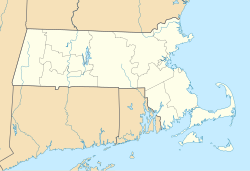Royall House and Slave Quarters: Difference between revisions
m Removed category Museums in Massachusetts (using HotCat) |
m Removed category Houses in Massachusetts (using HotCat) |
||
| Line 71: | Line 71: | ||
{{Registered Historic Places}} |
{{Registered Historic Places}} |
||
[[Category:Houses in Massachusetts]] |
|||
[[Category:Historic house museums in Massachusetts]] |
[[Category:Historic house museums in Massachusetts]] |
||
[[Category:Medford, Massachusetts]] |
[[Category:Medford, Massachusetts]] |
||
Revision as of 16:37, 8 August 2009
Isaac Royall House | |
 East (front) facade, built by Isaac Royall, Sr. over the original farmhouse | |
| Location | Medford, Massachusetts |
|---|---|
| Built | 1733 |
| Architect | Unknown |
| Architectural style | Georgian |
| NRHP reference No. | 66000786[1] |
| Significant dates | |
| Added to NRHP | October 15, 1966 |
| Designated NHL | October 9, 1960 |


The Isaac Royall House is a historic house located at 15 George Street, Medford, Massachusetts. It is a National Historic Landmark, operated as a non-profit museum, and open for public visits between June 1 and the last weekend in October.
The Royall House is notable for its excellent preservation, its possession of the only surviving slave quarters in Massachusetts, and its American Revolution associations with General John Stark, Molly Stark, and General George Washington. The objects within the house are miscellaneous though antique. Among the historic objects on display is a tea box, said to be from the same batch as dumped into Boston Harbor on the night of December 16, 1773 and a very small painting by John Singleton Copley of Isaac Royall, Jr. on copper.
Origins
The site's recorded history began about 1637 when Gov. John Winthrop built a house there. Around 1692, this house was replaced with a more imposing brick structure standing 2-1/2 stories high and one room in depth, with exceedingly thick walls. On December 26, 1732 Isaac Royall, Sr., a slave trader, rum distiller, and wealthy merchant of Antigua, purchased the house and more than 500 acres (2 km²) of land along the west bank of the Mystic River in Medford. He extensively remodeled the house between 1733-1737, adding a third story, encasing its east facade in clapboard, and ornamenting the exterior with architectural details and continuous strips of spandrel panels. Royall also constructed outbuildings in 1732, including the only known slave quarters to survive in New England today. After this construction, Royall brought 27 black slaves from Antigua. In so doing he doubled the number of slaves in Medford.
Early history
Isaac Royall, Jr. came into its possession in 1739, and greatly enlarged it between 1747 and 1750. He more than doubled the depth, greatly extended the brick end walls correspondingly, and constructed great twin chimneys at each end of the house, connected by parapets. Other features added by the younger Royall were the false ashlar siding on the new western facade, and great Doric pilasters inserted at the corners. The interior was redone in Georgian wooden paneling, trim, and archways possibly unsurpassed by any surviving house of the period. Today several of the major rooms are original; others have been reconstructed after Victorian remodeling.
In the American Revolution, the Royall family were British Loyalists, and as the British soldiers marched to the Battle of Lexington and Concord in 1775, the Royalls left Medford and boarded a ship in Boston. They sailed to Halifax, Nova Scotia and then on to England. Isaac Royall never again set foot in Medford.
After the Royalls' flight, the Massachusetts General Court confiscated the estate. General John Stark made the Royall House his headquarters before the evacuation of Boston by the British on March 17, 1776. The mansion was used during the early months of the Revolution by Generals Lee, Stark, and Sullivan, and was visited by George Washington who, according to legend, interrogated two British soldiers in the house's Marble Chamber. Molly Stark is said to have watched the movements of the British troops in camp by the river from a lookout on the roof.
In 1806, the estate was returned to Isaac Royall's heirs, who subsequently sold it. In accordance with Isaac Royall's will, a portion of his estate was donated to Harvard University and used to found Harvard Law School.
Preservation
In 1898, the Sarah Bradlee Fulton Chapter of the Daughters of the American Revolution conceived of the idea of preserving the Royall House "for the sake of its history and aesthetic value." On Patriots Day in 1898, they opened up the house to the public for a Loan Exhibition of colonial furnishings and valuable relics.
In 1907, this group of women recruited a wider group of "patriotic men and women" and formed the Royall House Association. The group's initial mission was to raise the necessary funds ($10,000) to purchase the house, the slave quarters and three-quarters of an acre of surrounding land to be maintained as a museum, which they ultimately were able to do in April 1908.
Over the years, the Royall House has undergone a number of interior and exterior restorations to its buildings and site, and in 1962, the Royall House was designated a National Historic Landmark.
Current operations
Public Programs
Research Partners
References
- ^ "National Register Information System". National Register of Historic Places. National Park Service. 2007-01-23.
External links
- Royall House (official web site)
- National Parks Service Royall House Page
- Royall House Association
- Museum Overview

